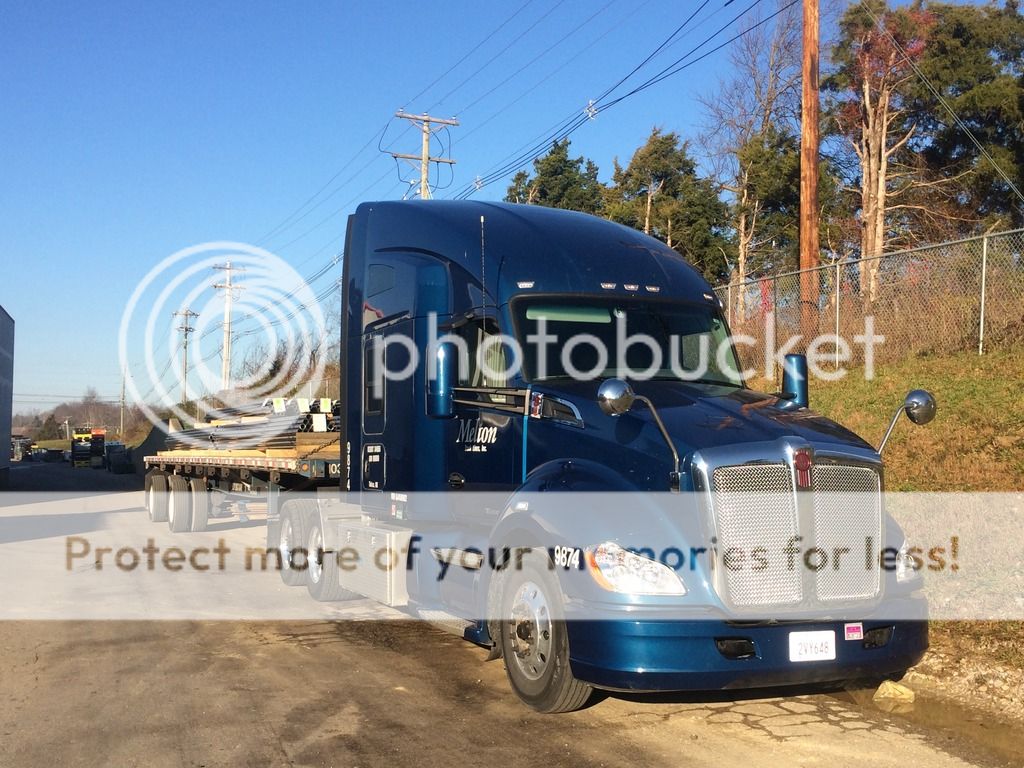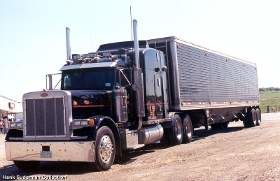Is It The Same As Driving A Standard (manual) Car?
Topic 11524 | Page 1

Sorta but not really. For one the rpm range on a diesel is different than a gas burner. Two, big trucks do not have syncronizers. This means you have to either double clutch or float the gears. Most schools and driving tests you have to double clutch. Once you get with a trainer though, I suggest learning to float. Your leg will thank you. The other difference is the splitter. With a 10-speed you go through the first 5, hit the splitter and go through 6-10. It gets just a bit more complicated with 13 speeds and up, but not so bad. What's really fun is driving an old 2 stick Mack. Seriously doubt you will ever see that. I learned to drive one when I was a log hauler.
Float The Gears:
An expression used to describe someone who is shifting gears without using the clutch at all. Drivers are taught to "Double Clutch" or press and release the clutch twice for each gear shift. If you're floating gears it means you're simply shifting without using the clutch at all.
Double Clutch:
To engage and then disengage the clutch twice for every gear change.
When double clutching you will push in the clutch, take the gearshift out of gear, release the clutch, press the clutch in again, shift the gearshift into the next gear, then release the clutch.
This is done on standard transmissions which do not have synchronizers in them, like those found in almost all Class A trucks.
Not the same and some of it will vary depending on the truck you get and the specs of the engine/transmission which the big boys are able to spec out to their liking.
Along with double clutching , you know how you push the clutch all the way in in a car? Don't need to in a lot of trucks, just push that clutch about one inch. You get used to it.
Good luck.
Double Clutch:
To engage and then disengage the clutch twice for every gear change.
When double clutching you will push in the clutch, take the gearshift out of gear, release the clutch, press the clutch in again, shift the gearshift into the next gear, then release the clutch.
This is done on standard transmissions which do not have synchronizers in them, like those found in almost all Class A trucks.
Double Clutching:
To engage and then disengage the clutch twice for every gear change.
When double clutching you will push in the clutch, take the gearshift out of gear, release the clutch, press the clutch in again, shift the gearshift into the next gear, then release the clutch.
This is done on standard transmissions which do not have synchronizers in them, like those found in almost all Class A trucks.

I suppose you already know that several companies are in the process, or have already, switched to fully automatic transmissions. I've heard that it was to help attract more women to trucking because many of them had fears of the gears. Anyway, if this is a concern for you then I would suggest trying to find a company that has automatics. My company, Epes Transport, started ordering all automatics because of the fuel mileage benefits. We have the new Detroit automatics and I have to say that I really like it compared to the Eaton automatics.
You hear a lot of guys saying that they will never drive an automatic and that they are for wimps (among other words), but after nearly 20 years of changing gears I'm tired of it and it only takes a few times getting stuck in Atlanta, Chicago, L.A., or the Cross Bronx during rush hour to change your way of thinking about them.
I think a lot of guys are just intimidated by them because they have heard things (usually untrue) about how you have no control while going down steep mountain grades, which is completely false. You have all the control in the world with them. Or you also hear how they are terrible in snow and that you get stuck a lot easier. Also untrue. I have had an automatic (2 that I owned and 3 company trucks) for a total of about 5 1/2 to 6 years total and the ONLY advantage that I have found is that if you kill your batteries and are able to get your truck rolling and have a manual trans is that you can get it started. Other than that call me lazy or a wimp, but give me my automatic. I like having the extra legroom to stretch out by not having a clutch pedal in the way.

I wouldn't recommend choosing a company based on whether they have automatics or not. There's no guarantee you'll get one if they still have a mix of automatic and manuals, and chances are whatever CDL school you go to, company or not, is going to have you learn to shift and test in a manual. If you test in an automatic you will have a restriction on your license that will prevent you from driving a manual and could be a problem in finding employment.
As to the original question, it's not the same but easy enough to learn whether you've driven a manual four wheeler or not.
CDL:
Commercial Driver's License (CDL)
A CDL is required to drive any of the following vehicles:
- Any combination of vehicles with a gross combined weight rating (GCWR) of 26,001 or more pounds, providing the gross vehicle weight rating (GVWR) of the vehicle being towed is in excess of 10,000 pounds.
- Any single vehicle with a GVWR of 26,001 or more pounds, or any such vehicle towing another not in excess of 10,000 pounds.
- Any vehicle, regardless of size, designed to transport 16 or more persons, including the driver.
- Any vehicle required by federal regulations to be placarded while transporting hazardous materials.
OOS:
When a violation by either a driver or company is confirmed, an out-of-service order removes either the driver or the vehicle from the roadway until the violation is corrected.

I personally won't drive an automatic but that's me everyone is different but i would make sure you learn a manual because my understanding coming here pretty soon they are going to start putting that as a restriction on people's license if they only drove an auto in school. I could be wrong but that's what I've been hearing from some of my dmv peeps I know. Now to answer the question at hand no it's not like one in a four wheeler but it's simple enough to get the hang of. Also you don't have to use the throttle to get the truck moving from a dead stop it'll roll on its own just from releasing the clutch.
Dm:
Dispatcher, Fleet Manager, Driver Manager
The primary person a driver communicates with at his/her company. A dispatcher can play many roles, depending on the company's structure. Dispatchers may assign freight, file requests for home time, relay messages between the driver and management, inform customer service of any delays, change appointment times, and report information to the load planners.DMV:
Department of Motor Vehicles, Bureau of Motor Vehicles
The state agency that handles everything related to your driver's licences, including testing, issuance, transfers, and revocation.

Thank you all. I'm not afraid of learning manual. I'm afraid of backing and parallel park. Although I do it like a champ with my big SUV, I'm sure it's quite different with a tractor/trailer.
New Reply:
New! Check out our help videos for a better understanding of our forum features

















Preview:








 TT On Facebook
TT On Facebook
Is driving a truck the same as driving a standard car? (Clutch, etc)?